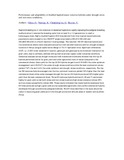Performance and adaptability of doubled haploid maize testcross hybrids under drought stress and non-stress conditions

View/
Date
2014Author
Odiyo, O
Njoroge, K
Chemining'wa, G
Beyene, Y
Language
enMetadata
Show full item recordAbstract
Haploid breeding via in vivo induction of maternal haploids is rapidly replacing the pedigree breeding methods since it reduces the breeding cycle from at least 6 to 1-2 generations to reach a homozygous state. Eighty doubled haploid (DH) lines derived from nine tropical maize backcross populations were crossed to two CIMMYT single cross testers (CML312/CML442 and CML395/CML444) in a North Carolina II mating design. The resultant 160 DH testcross hybrids and five commercial checks were evaluated across four well-watered locations and two drought stressed locations in Kenya using an alpha-lattice design of 15×11 replicated twice. Significant differences (0.05 < p < 0.001) were observed in location, genotype and genotype by environment interaction for grain yield, days to anthesis, anthesis-silking interval and ear aspect under nonstress conditions. Combined analyses across drought stress and well-watered environments showed that the top 20 hybrids performed better for grain yield and other agronomic traits of maize compared to the commercial checks. Grain yield for the top 20 DH hybrids ranged from 8.15-8.85 t/ha under optimum management and 4.53-5.67 t/ha under drought stress conditions while the best commercial variety yielded 7.67 t/ha and 3.43 t/ha under optimum and drought stress conditions, respectively. The top ten DH testcross hybrids averaged over the four optimum locations yielded 16% higher than the best commercial check while under managed drought the top ten DH hybrids produced 62% higher grain yield than the best commercial check. Three DH testcross hybrids entries 23, 28 and 71 performed highly for grain yield under both stress and non-stress locations high stress tolerance indices (STI) and low stress susceptibility indices (SSI). These results indicated that maize hybrids developed from DH lines produced as high a grain yield and as acceptable agronomic traits as the commercial hybrids developed through conventional pedigree methods. The DH lines identified in the study should be useful in improving grain yields and in the drought prone mid-altitude areas of eastern and southern Africa.
URI
http://www.cabdirect.org/abstracts/20143350126.html;jsessionid=8C8BBD7B1FDE7D54E2626C12E5F4287Dhttp://hdl.handle.net/11295/78451
